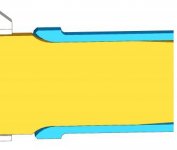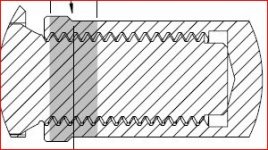Marc von Amsberg
Plastic
- Joined
- Sep 20, 2011
- Location
- Charlotte, NC, USA
Using medical grade Ti6Al4V, I'm press fitting a circular cylindrical male component 1.5mm (.059") in diameter x 5mm (.197") long. A taper is used at the tip for centering purposes. The mating female side is 2mm (.079") OD, with a corresponding cylindrical blind hole. Here a sketch of a similar cross section:

To be clear, the sketch is slightly different OD/ID, but the concept is the same. I'm using a modified fit out of machinery's handbook for tolerances, originally we tried a press fit with interference of 0.004 to 0.020 (.00015"-.0006"). As far as I know an arbor press was used for the press fit. In 3 samples, 1 of them separated under relatively light (think human applied) tensile and torsion forces. I'm trying to eliminate this failure.
Can anyone make any process change suggestions, or design improvements, which would improve this assembly? I am really appreciative of the method of joining process suggestions, e.g, anyone used dry ice/ liquid nitrogen with success? My theory of the first failure was the titanium wasn't ductile enough for the press fit, so this might be a really bad idea Is a miniature plug weld (laser weld) an option? I'm trying to not distort these miniature parts.
Is a miniature plug weld (laser weld) an option? I'm trying to not distort these miniature parts.

To be clear, the sketch is slightly different OD/ID, but the concept is the same. I'm using a modified fit out of machinery's handbook for tolerances, originally we tried a press fit with interference of 0.004 to 0.020 (.00015"-.0006"). As far as I know an arbor press was used for the press fit. In 3 samples, 1 of them separated under relatively light (think human applied) tensile and torsion forces. I'm trying to eliminate this failure.
Can anyone make any process change suggestions, or design improvements, which would improve this assembly? I am really appreciative of the method of joining process suggestions, e.g, anyone used dry ice/ liquid nitrogen with success? My theory of the first failure was the titanium wasn't ductile enough for the press fit, so this might be a really bad idea
 Is a miniature plug weld (laser weld) an option? I'm trying to not distort these miniature parts.
Is a miniature plug weld (laser weld) an option? I'm trying to not distort these miniature parts.






